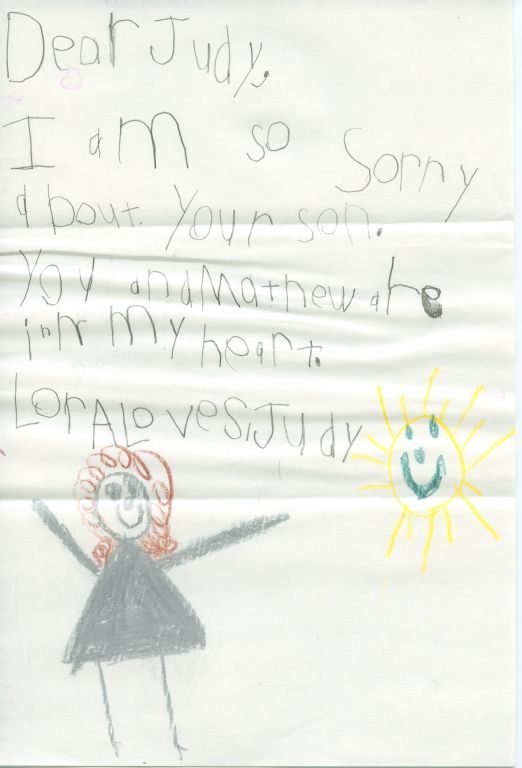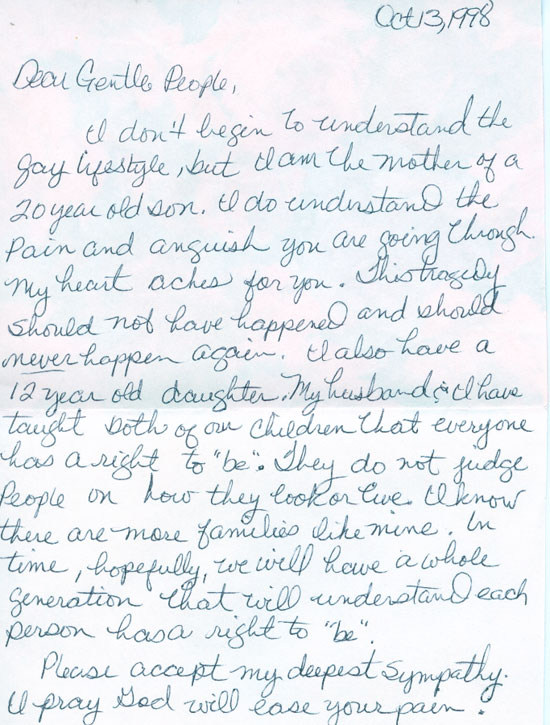
Where Matthew Lay Dying (Laramie, Wyoming), 2007 by Jeff Sheng
By Tracey Avant, Curator of Exhibitions at Ford’s Theatre
In 1998 Matthew Shepard was brutally murdered outside of his hometown of Laramie, Wyoming. Matthew was a college student and openly gay. The senselessness of the crime drew a response from thousands of people, many of whom felt compelled to write letters of support to Matthew’s parents, Dennis and Judy Shepard.
The crime also inspired a play, The Laramie Project which examines the reactions of the citizens of Laramie. The play premiered in 2000 in Denver and has since been presented worldwide, drawing both protest and praise.
In 2012 Ford’s Theatre announced it would produce The Laramie Project in the Fall of 2013 as part of The Lincoln Legacy Project, a multi-year effort to engage audiences and the District of Columbia area in dialogue on issues related to social justice, intolerance and diversity in the American landscape. At that time, I was asked to create an exhibition that would complement the play. My initial thought was to create something that would explore some of the social justice issues raised by The Laramie Project.
 All that changed when the director of Ford’s Theatre, Paul Tetreault, mentioned the exhibit we were planning to Judy Shepard. She told him of the thousands of letters she and her husband, Dennis, had received in the wake of Matthew’s attack, and then offered to let us borrow some for the exhibition.
All that changed when the director of Ford’s Theatre, Paul Tetreault, mentioned the exhibit we were planning to Judy Shepard. She told him of the thousands of letters she and her husband, Dennis, had received in the wake of Matthew’s attack, and then offered to let us borrow some for the exhibition.When Paul shared the offer with me, he proposed a new direction: What if we did the exhibit on just the letters? We agreed that it was an amazing opportunity to create an evocative and powerful, yet intimate, exhibition.
A team of four from Ford’s Theatre, including myself, flew out to conduct research at the Shepards’ home in Casper, Wyoming, for five days in April of 2013. We knew that there were approximately 10,000 letters stored in bins at the Shepards’ home, but we had no idea what to expect and whether the letters were organized in any way. What we found were 14 bins of letters and cards, most of which were still in their envelopes and rubber-banded in random bundles.
Fortunately, we had devised a plan to tackle the work before flying out to Wyoming. We brought with us two flatbed scanners, and we divided the team so that at any time two people were reading letters and selecting those to be scanned by the other two. As we worked, we would often stop for a moment and share with each other a letter or card that particularly touched us. It was an emotionally intense and exhausting experience reading so many people’s hopes for Matthew’s survival and so many more people’s condolences to the family.
One of my biggest concerns in conducting the research in the Shepards’ home was how to avoid intruding. I fretted over what the boundaries would be and whether it would be uncomfortable—for them or for us. In the end, all my worrying was for naught—Judy and Dennis Shepard are the kindest of people and their hospitality was endless. We had the good fortune to share lunches with them and two very special dinners, where we heard family stories and saw firsthand what incredibly strong and amazing people they are.
The exhibition itself is composed of two major elements. The first being a monumental 44-foot-long photograph by artist Jeff Sheng of the fence outside Laramie where Matthew Shepard was taken, tied and beaten to near death. The photo is life-sized and fills the entire length of one of the gallery walls. Eerie and stunning at the same time, it captures the beauty and harshness of Wyoming—a tension captured perfectly in The Laramie Project.
 The second component of the exhibit is the body of nearly 150 letters selected for display. They are divided into three sections: Embracing Empathy, Taking Responsibility and Speaking Up, Speaking Out.
The second component of the exhibit is the body of nearly 150 letters selected for display. They are divided into three sections: Embracing Empathy, Taking Responsibility and Speaking Up, Speaking Out.Each letter encourages the viewer to think about how we teach and encourage empathy, how as individuals we are responsible for the choices we make, and how those choices can positively or negatively impact the entire community. Each letter in the exhibition represents a hundred more similar in nature that remain tucked in their envelopes, safe within their bins back in Wyoming. We have highlighted letters from notable people in each section—President Bill Clinton, Father Roger who appears in The Laramie Project and Coretta Scott King (widow of Martin Luther King), to name just a few. But every other letter is just as special and was chosen because it told the most heartbreaking story, had the most endearing drawing, or shared the most uplifting message.
I know that this exhibition has the power to emotionally touch and create introspection in the viewer. My hope is that people will leave this exhibition with a better sense of the overall empathetic nature of our nation and—more importantly—energized to make the world a more accepting place for every individual.
Visit the Not In Our Town Facebook page to read letters from the exhibition and learn more about the Lincoln Legacy Project at Ford's Theatre.
Tracey Avant is the Curator of Exhibitions for Ford’s Theatre, the site of Abraham Lincoln’s assassination in 1865. Ford’s launched “The Lincoln Legacy Project” in September 2011 with a production of “Parade,” about the Leo Frank lynching in which anti-Semitism played a large part. The project continued in 2012 with a production of “Fly,” featuring the powerful story of the Tuskegee Airmen and their fight against racism at home and abroad. This year’s production of The Laramie Project will run Sept. 27-Oct. 27.
Related Content:
-
15 Years After Matthew Shepard’s Murder, His Story Still Reverberates by Ford’s Theatre Director Paul Tetreault
-
Not In Our Town Local Lesson: We Do Raise Kids Like That Here: A Student Reflects On a Peer's Murder and His Community's Response
-
Not In Our School Video: Staging a Response to Hate
-
Not In Our School Video: Angels Turn their Backs on Hate
-
Not In Our School Video: The Laramie Project: 10 Years Later